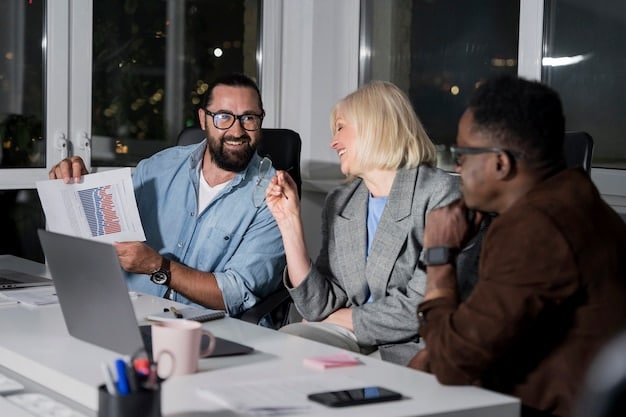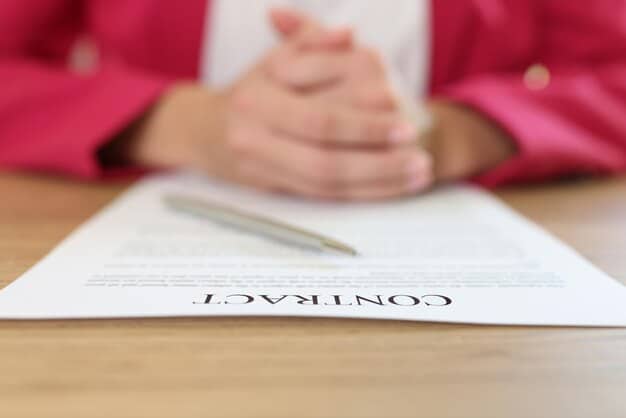US IP Protection for Startups: Practical Compliance Guide

Achieving robust intellectual property protection in the US is critical for startups, involving a strategic understanding of patents, trademarks, copyrights, and trade secrets to safeguard innovation and ensure long-term compliance within competitive markets.
Embarking on the startup journey in the highly competitive US market demands more than just innovative ideas; it requires a strategic approach to safeguarding your most valuable assets. This guide, “Ensure Compliance: A Practical Guide to US Intellectual Property Protection for Startups,” delves into the essential frameworks and practical steps necessary for protecting your intellectual property, ensuring your venture thrives securely and compliantly.
understanding intellectual property for startups
For any burgeoning startup, intellectual property (IP) represents the cornerstone of its future value. It encompasses the creative works, inventions, and brand identifiers that distinguish a company in the marketplace. Neglecting proper IP protection can expose your innovations to theft, dilution, and ultimately, significant financial and reputational loss. Understanding what constitutes IP and how to identify it within your own business is the critical first step in building a robust defense.
IP protection is not a one-time event; it’s an ongoing process that evolves with your company’s growth and innovation. Early identification and classification of your IP assets are paramount. This involves a thorough audit of your products, services, branding, and proprietary information to determine which forms of protection are most suitable. Ignoring this initial assessment can lead to costly remedies down the line or, worse, the irreversible loss of key competitive advantages.
types of intellectual property protection
In the US, several distinct forms of IP protection exist, each catering to different types of assets. Differentiating between them is crucial for effective strategy formulation.
- Patents: Protect novel inventions, processes, and designs, granting the inventor exclusive rights for a limited period. There are utility, design, and plant patents.
- Trademarks: Safeguard brand names, logos, slogans, and other identifiers that distinguish goods or services in the marketplace.
- Copyrights: Protect original works of authorship, including literary, dramatic, musical, and artistic works, both published and unpublished.
- Trade Secrets: Cover confidential business information that provides a competitive edge, such as formulas, practices, designs, or compilations of information, as long as it remains secret.
Each category has specific requirements for registration and enforcement. For instance, obtaining a utility patent can be a lengthy and complex process, often requiring specialized legal expertise, while copyright protection typically arises automatically upon creation. Understanding these nuances helps startups allocate resources efficiently and pursue the most effective protection methods.
Moreover, the strategic choice of IP protection should align with your business model and long-term goals. A software startup might prioritize copyright for its code and trademarks for its brand, while a biotech startup would heavily rely on patents for its novel compounds. A comprehensive IP strategy integrates these different forms of protection to create a multi-layered defense.
In essence, IP for startups is not merely a legal formality; it’s a strategic imperative. It’s about securing market exclusivity, attracting investment, and establishing a formidable barrier against competitors. By proactively identifying and categorizing their intellectual assets, startups lay a solid foundation for sustainable growth and innovation.
patents: securing your inventions
Patents stand as a formidable shield for inventive startups, granting the inventor exclusive rights to make, use, and sell their invention for a specified period. In the US, the patent system is designed to encourage innovation by providing inventors with a temporary monopoly in exchange for public disclosure of their invention. For startups, this exclusivity is invaluable, allowing them to recoup R&D costs and establish market dominance without immediate competition.
The patent application process is notoriously complex and resource-intensive, yet it is a non-negotiable step for any startup with pioneering technology. It involves detailed disclosure of the invention, including its functionality, composition, and novel aspects. A poorly drafted patent application can lead to rejection or, even worse, a patent that is easily circumvented or challenged, rendering your efforts futile.
navigating the patent application process
The journey to obtaining a US patent begins with a thorough novelty search. This crucial step helps determine if your invention already exists, is obvious, or has been publicly disclosed, which would prevent patentability. Professional patent search services or databases like the USPTO’s can greatly aid this process.
- Provisional Patent Application: Filing a provisional patent application can provide a cost-effective way to establish an early filing date (“patent pending” status) for one year, allowing time to refine the invention and assess its market potential before committing to a full non-provisional application.
- Non-Provisional Patent Application: This is the full application, requiring detailed specifications, drawings, and claims that precisely define the invention’s scope. It undergoes examination by a USPTO patent examiner.
- Response to Office Actions: During examination, the USPTO might issue “office actions” requesting clarifications or rejecting claims. Responding adeptly to these actions, often with legal counsel, is vital.
The time and expense involved in securing a patent can be substantial, often spanning several years and thousands of dollars. However, for genuinely innovative startups, the long-term benefits far outweigh these initial investments. A strong patent portfolio can significantly increase a startup’s valuation, attract investors, and deter potential infringers.
Beyond utility patents, which protect functionality, startups should also consider design patents for unique ornamental designs and plant patents for new plant varieties. Each serves a specific purpose in protecting different facets of innovation. Strategic use of these options can create a comprehensive protective layer around your product.
Ultimately, a deep understanding of the patent landscape and meticulous execution of the application process are paramount. Engaging experienced patent attorneys is often indispensable, as their expertise can navigate the intricacies of patent law, maximize your chances of success, and ensure your patents provide the robust protection your innovations deserve.
trademarks: building brand identity and recognition
For startups, a strong brand identity is as crucial as the innovation itself. Trademarks are the legal tools that protect this identity, encompassing names, logos, slogans, and other distinct symbols used to identify goods or services in the marketplace. A well-protected trademark differentiates your offering, builds consumer trust, and acts as a powerful asset for market recognition and growth.
Without proper trademark protection, your brand elements are vulnerable to imitation or unauthorized use by competitors, leading to consumer confusion and dilution of your brand equity. Registering your trademark with the United States Patent and Trademark Office (USPTO) provides nationwide protection and significantly strengthens your ability to enforce your rights against infringers.
the trademark registration pathway
The journey to trademark registration involves several key steps, each requiring careful attention to detail. Skipping any of these can lead to delays, rejections, or even legal disputes.
- Trademark Search: Before adopting and using a mark, conducting a comprehensive search is essential. This helps identify existing marks that are similar to yours and used on related goods or services, which could lead to a refusal from the USPTO or a costly infringement lawsuit.
- Filing Application: Once a unique mark is identified, an application is filed with the USPTO, specifying the goods or services the mark will cover. It’s crucial to correctly classify these goods/services to ensure adequate protection.
- Examination and Publication: A USPTO examiner reviews the application for compliance with federal law. If approved, the mark is published in the Official Gazette, allowing third parties to oppose its registration.
- Registration: If no oppositions are filed or if any are successfully overcome, the mark proceeds to registration, granting the owner exclusive rights to use the mark nationwide.
Beyond federal registration, startups can also acquire common law trademark rights through use in commerce, even without formal registration. However, these rights are geographically limited to the area where the mark is used. Federal registration provides much broader and stronger protection, offering prima facie evidence of validity and ownership.

Maintaining trademark rights requires ongoing vigilance. This includes continuously monitoring for potential infringements and renewing the registration periodically. Failure to monitor and enforce your trademark can lead to its abandonment or genericization, diminishing its value. Continuous use of the mark in commerce is also a mandatory requirement for maintaining its registration.
For startups, choosing a strong, distinctive trademark from the outset is a strategic decision that pays dividends in brand recognition and market positioning. Engaging legal counsel specializing in trademark law can help navigate the complexities of selection, clearance, registration, and enforcement, ensuring your brand identity is solidly protected.
copyrights: safeguarding creative works
Copyright protection is vital for startups whose core assets include creative or artistic expressions, such as software code, website content, marketing materials, literary works, or original designs. Unlike patents, which protect inventions, or trademarks, which protect brand identity, copyrights safeguard the expression of an idea, not the idea itself. This distinction is crucial for understanding its scope and application.
In the US, copyright protection arises automatically the moment an original work of authorship is fixed in a tangible medium of expression. This means you don’t necessarily need to register your work with the US Copyright Office to have basic protection. However, formal registration offers significant advantages, including the ability to sue for infringement in federal court and potentially recover statutory damages and attorney’s fees.
essential steps for copyright management
While automatic protection offers a baseline, strategic copyright management involves several proactive steps to maximize enforcement capabilities and ensure compliance.
- Identify Copyrightable Material: Regularly audit your startup’s creative output, including software code, website copy, graphics, videos, music, and internal documentation, to identify all copyrightable assets.
- Proper Authorship and Ownership: Ensure clear agreements are in place regarding authorship and ownership, especially with contractors or employees who create works “for hire.” Written contracts are critical to avoid future disputes.
- Copyright Registration: Though not mandatory, registering important works with the US Copyright Office provides public record of ownership and is a prerequisite for filing an infringement lawsuit. Registration is relatively inexpensive and straightforward.
For software startups, copyrighting source code is particularly important, as it protects the way the software is written. While patents cover the functional aspects of software, copyright shields its specific expression. This dual approach offers comprehensive protection for software-based innovations.
It’s also essential to be mindful of third-party copyrights when developing content or software. Using copyrighted material without permission can lead to infringement claims. Always secure licenses or permissions, or create truly original content to mitigate risks. Proper attribution and understanding of “fair use” principles are also important considerations.
Moreover, startups should implement internal policies and training regarding copyright compliance to ensure all employees understand their responsibilities. This includes guidelines on creating original content, proper licensing of external materials, and handling confidential information that might be subject to copyright.
Ultimately, a robust copyright strategy enables startups to protect their digital and creative assets, providing a strong foundation for their online presence, marketing efforts, and proprietary software, while mitigating the risks of infringement claims both as a plaintiff and defendant.
trade secrets: protecting confidential business data
Trade secrets represent a vital, yet often overlooked, form of intellectual property protection for startups. They encompass confidential business information that provides a competitive edge because it is secret. This can include formulas, practices, designs, instruments, patterns, compilations of information, programs, or methods. Unlike patents, trademarks, or copyrights, trade secrets do not require registration with any government body; their protection hinges entirely on maintaining their secrecy.
For a startup, trade secrets can be fundamental to its operations and market differentiation. Think about a unique algorithm that optimizes your service, a proprietary customer list, a secret manufacturing process, or even a nuanced marketing strategy. These can all be powerful trade secrets, provided they are kept confidential and derive economic value from their secrecy.
strategies for trade secret protection
The core principle of trade secret protection is the implementation of reasonable measures to maintain secrecy. Without demonstrable efforts to protect the information, it may not qualify as a trade secret under law.
- Non-Disclosure Agreements (NDAs): Crucial for any interactions with employees, contractors, partners, and potential investors. NDAs legally bind individuals to keep shared confidential information secret.
- Restricted Access: Limit access to sensitive information only to those who need to know it. This includes physical security, password protection, and digital access controls.
- Employee Training and Policies: Educate employees on the importance of trade secrets and establish clear internal policies regarding the handling and dissemination of confidential information.
- Marking Confidential Documents: Clearly label confidential documents and data as “Proprietary” or “Confidential” to signify their protected status.
The Uniform Trade Secrets Act (UTSA), adopted by most US states, governs trade secret law. It defines what constitutes a trade secret and outlines remedies for misappropriation. Misappropriation occurs when a trade secret is acquired by improper means (e.g., theft, espionage) or disclosed/used without authorization by someone who obtained it improperly or knew it was a trade secret.

Maintaining trade secret status requires continuous vigilance. If a trade secret becomes publicly known through legitimate means (e.g., reverse engineering, independent discovery), the legal protection as a trade secret ceases. This is a key distinction from patents, which offer protection even if the invention is independently discovered after patenting.
For startups, a hybrid approach, leveraging both registered IP (patents, trademarks, copyrights) and trade secret protection, often provides the most comprehensive defense. For instance, while a patent might protect the functional aspect of a new device, the specific, intricate manufacturing process to produce it efficiently could be protected as a trade secret.
Effectively managing trade secrets is about creating a culture of confidentiality within your organization, reinforced by legal agreements and robust security measures. This ensures that your most sensitive and valuable operational data remains a key competitive asset.
enforcement and compliance strategies
Having intellectual property rights is only half the battle; the other half involves actively enforcing those rights and maintaining continuous compliance. For startups, understanding how to defend their IP and avoid infringing on others’ rights is crucial for sustainable growth and avoiding costly legal battles. Proactive enforcement deters potential infringers, while diligent compliance mitigates legal risks.
The digital age only amplifies the need for vigilance. Online platforms, global markets, and ease of information sharing make IP infringement more prevalent and complex to combat. Startups must develop a strategy to monitor, detect, and respond to potential infringements effectively.
monitoring and dispute resolution
Effective IP enforcement starts with continuous monitoring of the marketplace for unauthorized use of your patents, trademarks, copyrights, or trade secrets. This can include:
- Online Monitoring: Using specialized services or in-house searches to detect unauthorized use of your brand names, logos, or copyrighted content on websites, social media, and e-commerce platforms.
- Competitive Intelligence: Staying informed about competitors’ products and activities to identify potential patent or trade secret infringements.
- Cease and Desist Letters: Often the first step in addressing infringement. These letters formally demand that the infringing party stop their unauthorized activities.
- Litigation: If amicable solutions fail, pursuing legal action in federal court may be necessary. This is a costly and time-consuming process, but sometimes indispensable for protecting core assets.
Simultaneously, startups must prioritize compliance to avoid infringing on the IP of others. This involves thorough due diligence, especially when developing new products, services, or brand elements. Conducting comprehensive searches for patents, trademarks, and existing copyrights before launch can significantly reduce the risk of future legal challenges.
Another often-overlooked aspect of compliance involves open-source software. While open-source can offer significant benefits, many licenses come with specific requirements regarding attribution or even “copyleft” provisions, which might require you to make your own code open-source if you integrate certain components. Understanding and adhering to these licenses is crucial.
Employee education plays a critical role in both enforcement and compliance. Training staff on IP policies, confidentiality protocols, and how to identify potential infringement or avoid accidental infringement—for instance, by understanding proper use of third-party content—is fundamental. A robust internal IP compliance program establishes a culture of respect for intellectual property assets, both your own and others’.
In essence, IP enforcement and compliance are two sides of the same coin: protecting your innovations while navigating the complex legal landscape responsibly. Startups that strategically invest in these areas position themselves for sustainable growth, minimize legal liabilities, and solidify their market position.
leveraging ip for funding and growth
For startups, intellectual property is far more than just a legal safeguard; it is a powerful asset that can significantly impact valuation, attract investors, and fuel long-term growth. Savvy investors recognize that a robust IP portfolio signals innovation, market exclusivity, and a defensible competitive advantage, making a startup a more attractive investment opportunity.
Especially in technology-driven sectors, IP often constitutes the primary value of a startup. A well-secured patent or a distinctive trademark can differentiate a company from its peers, create barriers to entry for competitors, and demonstrate a clear path to market leadership. This strategic value translates directly into increased investor confidence and a stronger negotiating position during fundraising rounds.
ip as an asset for investment and scaling
Presenting a clear, well-articulated IP strategy is critical when pitching to venture capitalists or angel investors. They want to see that you not only have groundbreaking ideas but also the foresight to protect them.
- Increased Valuation: Patents and strong trademarks can significantly boost a startup’s valuation by demonstrating unique market position and reduced risk of imitation.
- Attracting Investors: Investors are more likely to fund startups with defensible IP, as it offers a clearer path to profitability and exit strategies. It shows the startup has a tangible competitive moat.
- Licensing Opportunities: Developed IP can be licensed to other companies, creating new revenue streams without directly deploying the technology or product. This diversifies income and capitalizes on your innovation.
- Mergers & Acquisitions (M&A): A strong IP portfolio makes a startup a much more attractive acquisition target for larger companies looking to expand their technology or market presence.
Consider the due diligence process during funding rounds. Investors meticulously examine a startup’s IP assets, checking for clarity of ownership, scope of protection, and potential infringement risks. A disorganized or weak IP portfolio can be a major red flag, deterring otherwise interested parties.
Beyond direct funding, IP can be leveraged for growth in various ways. Expanding internationally? Your trademarks and patents need protection in target markets to ensure your brand and inventions aren’t copied. Developing new product lines? Ensure your existing IP can support or be extended to cover these new ventures.
Furthermore, actively managing and nurturing your IP involves continuous innovation and strategic patenting or trademarking of new developments. This ensures that your IP portfolio remains dynamic and relevant, reflecting the ongoing evolution of your products and services and maintaining your competitive edge.
In essence, seeing IP as an investment rather than merely an expense transforms it into a powerful engine for fundraising, strategic partnerships, and long-term sustainable growth. Startups that integrate IP protection into their core business strategy are better positioned to secure capital and succeed in the competitive startup ecosystem.
| Key Aspect | Brief Description |
|---|---|
| 💡 Patents | Protect new inventions, processes, and designs, granting exclusive rights for a limited time. |
| ™️ Trademarks | Safeguard brand names, logos, and slogans, distinguishing goods or services in the market. |
| ©️ Copyrights | Protect original creative works like software code, content, and art. |
| 🤫 Trade Secrets | Guard confidential business information that provides a competitive edge, needing active secrecy. |
frequently asked questions
IP protection is crucial for US startups because it safeguards their unique innovations, brand identity, and creative works from imitation and theft. It establishes market exclusivity, enhances company valuation, and attracts investors who seek defensible assets, ensuring a competitive advantage and long-term sustainability within a dynamic market landscape.
A patent protects novel inventions, processes, and designs, granting exclusive rights to the inventor for a limited period to make, use, and sell the invention. A trademark, conversely, protects brand names, logos, and slogans, distinguishing goods or services in the marketplace and preventing consumer confusion. They serve distinct but complementary purposes in IP strategy.
No, copyright protection in the US arises automatically the moment an original work of authorship is fixed in a tangible medium. However, registering your copyright with the US Copyright Office offers significant benefits, including the ability to sue for infringement in federal court and potentially recover statutory damages and attorney’s fees.
Startups protect trade secrets by implementing reasonable measures to maintain their secrecy. This includes using non-disclosure agreements (NDAs) with employees and partners, restricting access to sensitive information, regularly training staff on confidentiality policies, and clearly marking confidential documents. Active efforts to keep information secret are paramount for legal protection.
Intellectual property plays a critical role in attracting startup funding by signaling innovation, market exclusivity, and a defensible competitive advantage. A robust IP portfolio increases a startup’s valuation and makes it more appealing to investors who seek to minimize risk and capitalize on unique, protected assets, solidifying investor confidence.
conclusion
Navigating the complex landscape of intellectual property protection is a strategic imperative for any startup aiming for sustainable growth and long-term success in the US market. From understanding the nuances of patents, trademarks, and copyrights to rigorously protecting trade secrets and ensuring ongoing compliance, a proactive approach to IP safeguards innovation, enhances market value, and fosters investor confidence. By embedding intellectual property considerations into their core business strategy, startups not only minimize legal risks but also cultivate a powerful competitive advantage that drives their journey from inception to market leadership.





